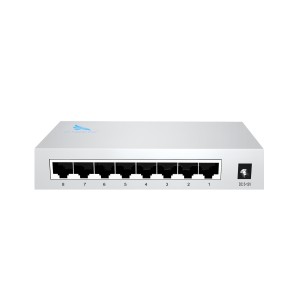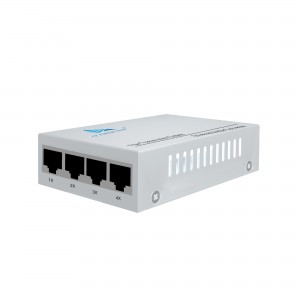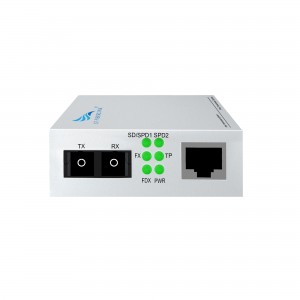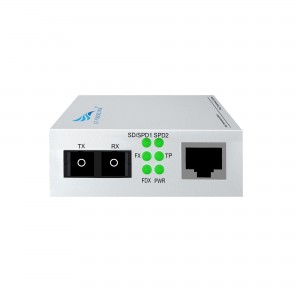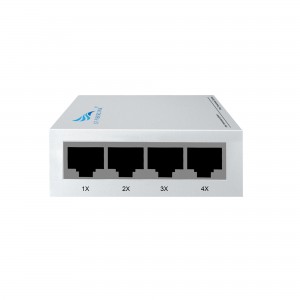9-port 10/100M Media Converter (multi-mode Dual-fiber SC)
9-port 10/100M Media Converter (multi-mode Dual-fiber SC)
Product Features:
Huizhou Changfei Optoelectronics Technology Co., Ltd. launched a revolutionary digital fiber converter
Huizhou Changfei Optoelectronics Technology Co., Ltd. is proud to present its latest innovation – Digital Fiber Converter. As a professional manufacturer of industrial intelligent management switches, PoE switches, Ethernet switches, wireless bridges, wireless 4G routers in China, we always put quality and innovation first. Now, we’re setting a new standard with state-of-the-art digital to optical converters.
Our digital fiber converters combine the best of optical and electrical technology with impressive 1 fiber and 8 electrical multimode dual fiber capabilities. This enables seamless transfer of data, ensuring reliable and efficient performance. Whether you are looking to enhance your existing telecommunications infrastructure, or looking for a reliable connectivity solution in challenging environments, our digital fiber converters are the perfect choice.
Engineered with the highest precision, our digital to fiber converters are iron-cased for optimum protection and durability. Its IP30 degree of protection ensures it can withstand harsh conditions and function flawlessly in demanding industrial environments. You can trust our digital to optical converters to deliver exceptional performance, day in and day out.
To further enhance its functionality, our digital fiber converters are equipped with an external power supply to ensure a stable and consistent power supply. This eliminates any disruption or downtime that may occur due to power fluctuations. With our digital to fiber converters, you can rest assured that your data transmission will continue uninterrupted for seamless business operations.
Additionally, our digital to fiber converters feature an SC interface for hassle-free connection. The SC interface ensures a secure and stable connection between your existing infrastructure and our converters, ensuring smooth data transmission. With our converters, you can easily bridge the gap between fiber optic and electrical networks, simplifying your operations and increasing efficiency.
To sum up, the digital optical fiber converter of Huizhou Changfei Optoelectronics Technology Co., Ltd. is a breakthrough product that combines the essence of optoelectronic technology. With its outstanding features such as 1 optical and 8 electrical multimode dual fiber connections, iron housing design, IP30 protection level, external power supply and SC interface, this converter revolutionizes data transmission in industrial environments.
So why wait? Upgrade your telecommunications infrastructure with reliable and efficient digital fiber optic converters from Huizhou Changfei Optoelectronics Technology Co., Ltd. Embrace the future of connectivity and experience seamless data transfer like never before. Contact us today and let our innovative solutions drive your success.
What This Product Does
◇ The CF-1028MW-2 is a media converter designed to convert 100BASE-FX fiber to 100Base-TX copper media or vice versa. Designed under IEEE 802.3u 10/100Base-TX and 100Base-FX standards, the CF-1028MW-2 is designed for use with multi-mode fiber cable utilizing the SC-Type connector. The CF-1028MW-2 supports longwave (LX) laser specification at a full wire speed forwarding rate. It works at 1310nm on both transmitting and receiving data.
◇ Other features of this module include the ability to be used as a stand alone device (no chassis required), Auto MDI/MDI-X for TX port, Auto negotiation of duplex mode. The CF-1028MW-2 will transmit at extended fiber optic distances utilizing multi-mode fiber up to 2 kilometers.
Other Features
◇ Besides, this media converter can be used as a standalone device (no rack required) or used with CF FIBERLINK’s CF-2U14 rack for auto MDI/MDI-X in TX port in which duplex mode is automatically negotiated.
technical parameter:
|
Model |
CF-1028MW-2 | |
| Interface Characteristics | ||
|
Fixed Port |
8* 10/ 100Base-TX RJ45 port 1* 155M uplink SC fiber port |
|
|
Ethernet Port |
10/ 100Base-TX auto-sensing, full/half duplex MDI/MDI-X self-adaption |
|
|
Twisted Pair Transmission |
10BASE-T: Cat3,4,5 UTP(≤100 meter) 100BASE-T: Cat5e or later UTP(≤100 meter) |
|
| Optical Port | The default optical module is multimode dual fiber 2km, SC port | |
| Wavelength/Distance | multimode: 850nm 0~550M,1310nm 0~2KM | |
| Chip Parameter | ||
| Network Protocol | IEEE802.3 10BASE-T, IEEE802.3i 10Base-T,
IEEE802.3u 100Base-TX, IEEE802.3u 100Base-FX, IEEE802.3x |
|
|
Forwarding Mode |
Store and Forward(Full Wire Speed) |
|
|
Switching Capacity |
1.8Gbps |
|
|
Buffer Memory |
1.33Mpps | |
|
MAC |
1K | |
|
LED Indicator |
Fiber | FX(green) |
| Data | 1/2/3/4/5/6/7/8(green) | |
| Power | PWR (green) | |
| Power | ||
| Working Voltage |
AC:100-240V |
|
|
Power Consumption |
Standby<1W, Full load<5W |
|
|
Power Supply |
DC:5V/2A industrial power supply |
|
| Lightning protection &Certification | ||
| Lightning protection | Lightning protection: 4KV 8/20us, Protection level: IP30 | |
| Certification | CCC;CE mark, commercial; CE/LVD EN60950;FCC Part 15 Class B; RoHS | |
| Physical Parameter | ||
| Operation TEMP | -20~+55°C;5%~90% RH Non condensing | |
| Storage TEMP |
-40~+85°C;5%~95% RH Non condensing |
|
| Dimension (L*W*H) | 140mm* 80mm*28mm | |
| Installation | Desktop, CF-2U14 slot rack | |
Product Size:
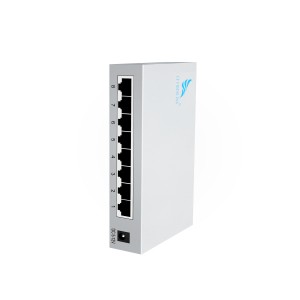
Product application diagra:

How to choose a fiber optic transceiver?
Optical fiber transceivers break the 100-meter limitation of Ethernet cables in data transmission. Relying on high-performance switching chips and large-capacity caches, while truly achieving non-blocking transmission and switching performance, they also provide balanced traffic, isolation and conflict. Error detection and other functions ensure high security and stability during data transmission. Therefore, fiber optic transceiver products will still be an indispensable part of actual network construction for a long time. So, how should we choose fiber optic transceivers?
1. Port function test
Mainly test whether each port can work normally in the duplex state of 10Mbps, 100Mbps and half-duplex state. At the same time, it should be tested whether each port can automatically select the highest transmission speed and automatically match the transmission rate of other devices. This test can be included in other tests.
2. Compatibility test
It mainly tests the connection ability between the optical fiber transceiver and other devices compatible with Ethernet and Fast Ethernet (including network card, HUB, Switch, optical network card, and optical switch). The requirement must be able to support the connection of compatible products.
3. Cable connection characteristics
Test the fiber optic transceiver’s ability to support network cables. First, test the connection ability of Category 5 network cables with lengths of 100m and 10m, and test the connection ability of long Category 5 network cables (120m) of different brands. During the test, the optical port of the transceiver is required to have a connection capability of 10Mbps and a rate of 100Mbps, and the highest must be able to connect to a full-duplex 100Mbps without transmission errors. Category 3 twisted pair cables may not be tested. Subtests can be included in other tests.
4. Transmission characteristics (transmission loss rate of data packets of different lengths, transmission speed)
It mainly tests the packet loss rate when the optical fiber transceiver optical port transmits different data packets, and the connection speed under different connection rates. For the packet loss rate, you can use the test software provided by the network card to test the packet loss rate when the packet size is 64, 512, 1518, 128 (optional) and 1000 (optional) bytes under different connection rates. , the number of packet errors, the number of packets sent and received must be more than 2,000,000. Test transmission speed can use perform3, ping and other software.
5. The compatibility of the whole machine to the transmission network protocol
It mainly tests the compatibility of fiber optic transceivers to network protocols, which can be tested in Novell, Windows and other environments. The following low-level network protocols such as TCP/IP, IPX, NETBIOS, DHCP, etc. must be tested, and the protocols that need to be broadcast must be tested. Optical transceivers are required to support these protocols (VLAN, QOS, COS, etc.).
6. Indicator status test
Test whether the status of the indicator light is consistent with the description of the panel and the user manual, and whether it is consistent with the current status of the fiber optic transceiver.








